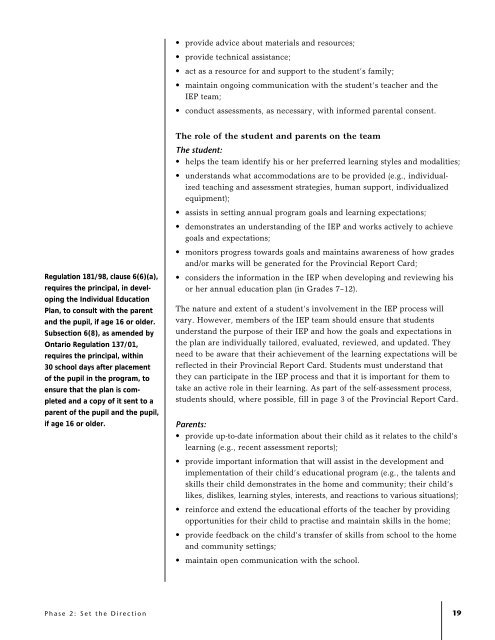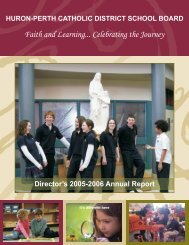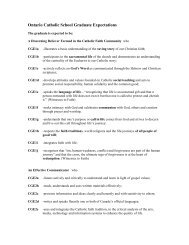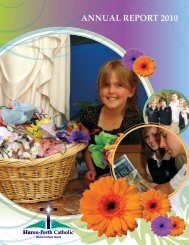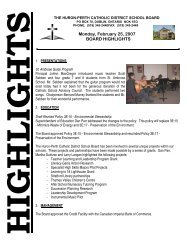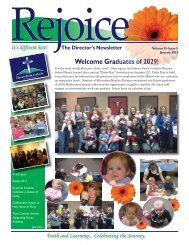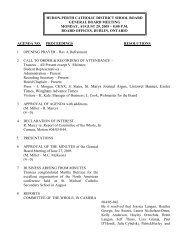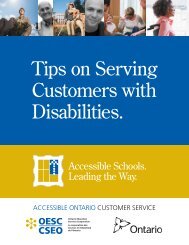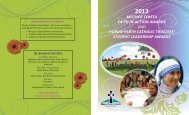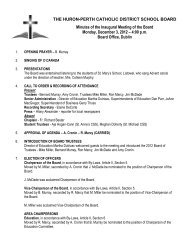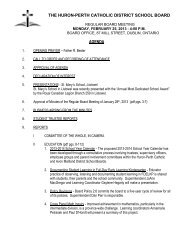The Individual Education Plan (IEP) - A Resource Guide, 2004
The Individual Education Plan (IEP) - A Resource Guide, 2004
The Individual Education Plan (IEP) - A Resource Guide, 2004
Create successful ePaper yourself
Turn your PDF publications into a flip-book with our unique Google optimized e-Paper software.
• provide advice about materials and resources;<br />
• provide technical assistance;<br />
• act as a resource for and support to the student’s family;<br />
• maintain ongoing communication with the student’s teacher and the<br />
<strong>IEP</strong> team;<br />
• conduct assessments, as necessary, with informed parental consent.<br />
Regulation 181/98, clause 6(6)(a),<br />
requires the principal, in developing<br />
the <strong>Individual</strong> <strong>Education</strong><br />
<strong>Plan</strong>, to consult with the parent<br />
and the pupil, if age 16 or older.<br />
Subsection 6(8), as amended by<br />
Ontario Regulation 137/01,<br />
requires the principal, within<br />
30 school days after placement<br />
of the pupil in the program, to<br />
ensure that the plan is completed<br />
and a copy of it sent to a<br />
parent of the pupil and the pupil,<br />
if age 16 or older.<br />
<strong>The</strong> role of the student and parents on the team<br />
<strong>The</strong> student:<br />
• helps the team identify his or her preferred learning styles and modalities;<br />
• understands what accommodations are to be provided (e.g., individualized<br />
teaching and assessment strategies, human support, individualized<br />
equipment);<br />
• assists in setting annual program goals and learning expectations;<br />
• demonstrates an understanding of the <strong>IEP</strong> and works actively to achieve<br />
goals and expectations;<br />
• monitors progress towards goals and maintains awareness of how grades<br />
and/or marks will be generated for the Provincial Report Card;<br />
• considers the information in the <strong>IEP</strong> when developing and reviewing his<br />
or her annual education plan (in Grades 7–12).<br />
<strong>The</strong> nature and extent of a student’s involvement in the <strong>IEP</strong> process will<br />
vary. However, members of the <strong>IEP</strong> team should ensure that students<br />
understand the purpose of their <strong>IEP</strong> and how the goals and expectations in<br />
the plan are individually tailored, evaluated, reviewed, and updated. <strong>The</strong>y<br />
need to be aware that their achievement of the learning expectations will be<br />
reflected in their Provincial Report Card. Students must understand that<br />
they can participate in the <strong>IEP</strong> process and that it is important for them to<br />
take an active role in their learning. As part of the self-assessment process,<br />
students should, where possible, fill in page 3 of the Provincial Report Card.<br />
Parents:<br />
• provide up-to-date information about their child as it relates to the child’s<br />
learning (e.g., recent assessment reports);<br />
• provide important information that will assist in the development and<br />
implementation of their child’s educational program (e.g., the talents and<br />
skills their child demonstrates in the home and community; their child’s<br />
likes, dislikes, learning styles, interests, and reactions to various situations);<br />
• reinforce and extend the educational efforts of the teacher by providing<br />
opportunities for their child to practise and maintain skills in the home;<br />
• provide feedback on the child’s transfer of skills from school to the home<br />
and community settings;<br />
• maintain open communication with the school.<br />
Phase 2: Set the Direction<br />
19


